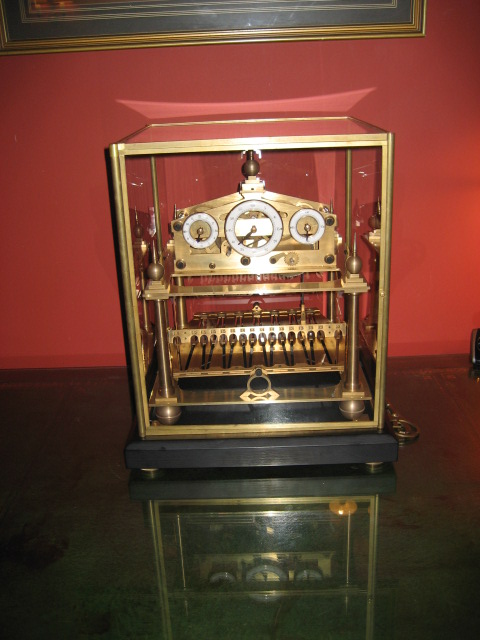
| WWT Shows | CLICK TO: Join and Support Internet Horology Club 185™ | IHC185™ Forums |

|
• Check Out Our... • • TWO Book Offer! • |
Welcome Aboard IHC185™  Internet Horology Club 185
Internet Horology Club 185  IHC185™ Discussion Site Main Page
IHC185™ Discussion Site Main Page  Horological Discussions, Questions and Answers
Horological Discussions, Questions and Answers  Clocks, Including 400-Day Discussions
Clocks, Including 400-Day Discussions  Congreve Rolling Ball Clock
Congreve Rolling Ball Clock
 Internet Horology Club 185
Internet Horology Club 185  IHC185™ Discussion Site Main Page
IHC185™ Discussion Site Main Page  Horological Discussions, Questions and Answers
Horological Discussions, Questions and Answers  Clocks, Including 400-Day Discussions
Clocks, Including 400-Day Discussions  Congreve Rolling Ball Clock
Congreve Rolling Ball ClockGo  | New Topic  | Find-Or-Search  | Notify  | Tools  | Reply to Post  |  |
Hi everyone, This is just a quick question because I know the topic can be a bore to anybody who is exact with their time-keeping and unamused by novelty. I own a Congreve clock and am interested in finding others who want to discuss their woes and joys and generally build information on the subject. If anybody has some information such as the 'Devon Clocks' setup guide, I would very much like to see it. Kind regards and best wishes, Al | |||
|
| Administrative Assistant |
Hello Fred! Did a Google Search for "Congreve Rolling Ball Clock" and saw this post on "YouTube" and found it fascinating. Can you share more information with us? Thanks, Debbie | |||
|
Hello Debbie, Lovely to hear from you! My Congreve runs for 8 days and is very similar to the John Wilding skeletonised table version. I am aware that it was manufactured in China (it has a G on the key but no other markings) - although I've read some negative information about these copies mine does run reasonably well. There is so little information available for even simple recommendations like 8-daily cleaning of the ball and Why I have a steel cross brace under the 30 second table rather than a brass one? (it certainly does react like a bi-metallic strip in warm weather). Even simple things with this interesting novelty timepiece can seem illogical at first. Whilst the table must be level to enable the ball to run unhindered small adjustments need to be made for any errors in the table itself. At each end of the table the ball hits a lever which trips the detent. By trial and error the force of the ball must be judged to hit the lever without it tripping twice - Therefore allowing the table to return to the same end position. The levers can also give a little momentum to the ball on it's return journey and so this process continues. In order to adjust the incline of the table and so decrease or increase the speed of the ball (Which should of course take 30 seconds each journey (or 15 depending on which version you have)) the adjustable crank, connected directly to the minute wheel (and paused by the detent),can be used - the rod that is between this crank and the table itself (Which effectively lifts and drops the table) is also adjustable to allow for an even balance. If I haven't now succeeded in either confusing everyone and possibly boring the pants off fellow forum members I will finish in short by saying that once functioning, all variables are affected by an adjustment. Whether the ball has been slowed down or speeded up, adjustment to the detent levers and indeed the level (especially if a slower speed is needed) of the table must be made. There must be a logical way to understand how these variables relate and therefore why a clock might not run efficiently. So I hope that with other owners and suitable minds a stoppage flowchart could be produced. I understood the possible frustrations with this clock when I bought it and I knew that it was not for the beginner but my interest and love, despite the joys and woes continues. Warmest wishes Fred  | ||||
|
I started building a John Wilding version over 30 years ago (I have the book)but got bored with filing the triangles for the table. I guess that I ought to dig it out and finish it! I am much wiser now. | ||||
|
Hi Clive, I can only guess that the filing must become a chore very quickly. I am in awe of anybody who would attempt this 'build'. Which Westbrook? I'm looking for a winter project. | ||||
|
Westbrook near Margate. Filing probably isn't too bad; I was young then and probably impatient! There is always so much to do, usually working on other peoples clocks! The book by John Wilding is probably still available and at least one supplier that I know off will supply the wheels (either crossed out or not crossed out) if you don't want to cut your own | ||||
|
I do have his book. I guess I skipped the middle section of the whole deal. (I have a Lathe and a Congreve). Although, I would love in the future to consider making an example (I think I'd feel a cheat if I did not make my own wheels)it is a very long way off. In the mean time, as you are aware of the need for accuracy with this beast, how would you go about ironing out the errors in the table? Mine is a little too fussy in several areas. I have in the past taken each of the seventy odd screws out and 'trued' the parts on a flat surface but this has not corrected anything. Any suggestions? Warmest wishes, Fred | ||||
|
| Powered by Social Strata |
| Your request is being processed... |
|
©2002-2025 Internet Horology Club 185™ - Lindell V. Riddle President - All Rights Reserved Worldwide

